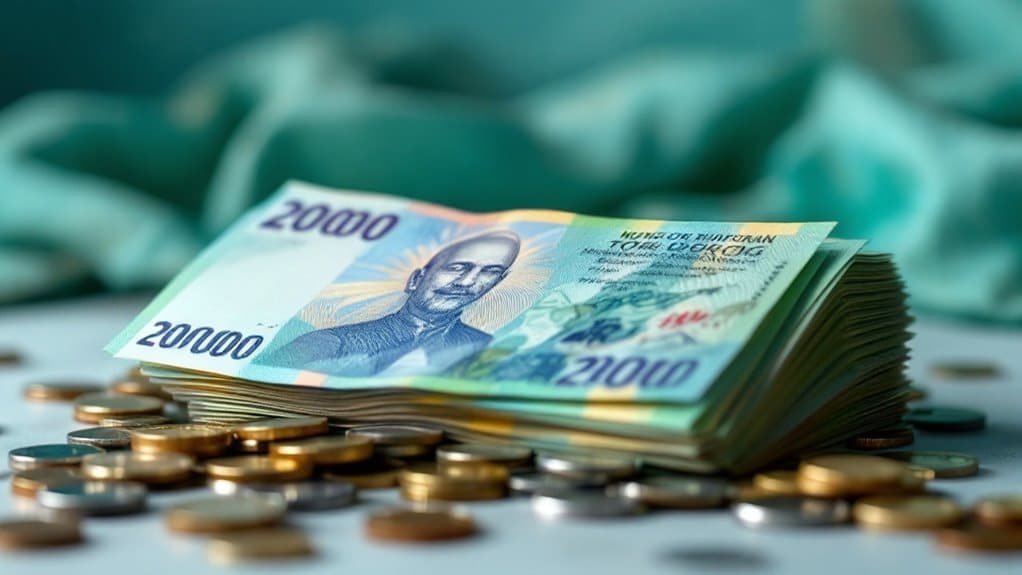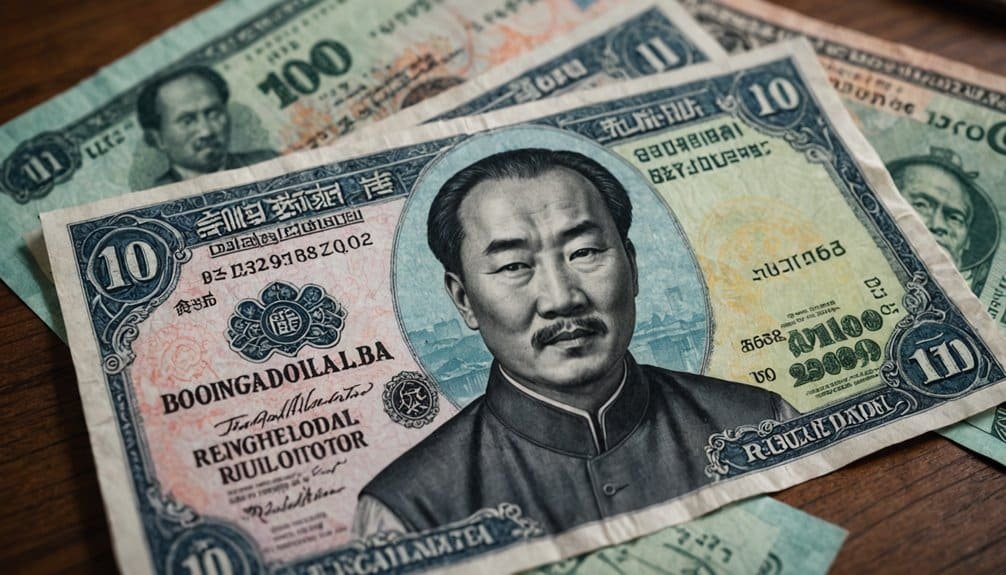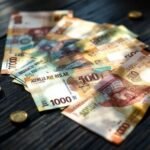
You'll likely encounter Mongolia's tögrög as a primary means of exchange during your visit to the Land of Blue Sky. Introduced in 1925, the tögrög is subdivided into 100 möngö and influenced by inflation trends, with the Bank of Mongolia focusing on managing money supply and market interest rates. Available in various banknote denominations, from 1 to 20,000 tögrög, and coin denominations of 20 to 500 tögrög, the currency's value fluctuates due to economic changes and monetary policies. To navigate the exchange rates and economic impact, understanding the tögrög's history, current trends, and market dynamics is essential for effective financial planning in Mongolia.
Key Takeaways
- Mongolia's tögrög was introduced in 1925 and initially backed by precious metals and high-liquidity goods.
- The currency is subdivided into 100 möngö and influenced by central bank interventions and inflation trends.
- Banknotes range from 1 to 20,000 tögrög, while coins are available but rarely used in daily transactions.
- The tögrög's value significantly devalued in the 1990s, impacting the economy, and current exchange rates fluctuate due to economic changes.
- The mining sector significantly influences the tögrög's economic impact, contributing to average annual economic growth of around 5%.
Overview of the Tögrög
The tögrög, Mongolia's national currency, has a rich history dating back to its introduction in December 1925, following a resolution from the Bank of Mongolia.
Initially, the currency was backed by precious metals and high-liquidity goods, as mandated by the Monetary Reform Act of 1925. Over time, the tögrög's currency design has undergone changes, but its core function remains the same.
You'll notice that the currency's value has fluctuated considerably, influenced by inflation trends. Mongolia has experienced high inflation in the past, but the Bank of Mongolia aims to maintain low levels of inflation to support economic growth and public trust.
The currency is subdivided into 100 möngö, with its exchange rate Floating Exchange Rate influenced by the Bank of Mongolia's interventions.
This objective guides the central bank's monetary policy, which focuses on managing the money supply and influencing money market interest rates.
Tögrög Denominations and Usage
Mongolia's monetary system relies heavily on its currency denominations, which play a significant role in facilitating daily transactions.
You'll find tögrög banknotes in various denominations, including 1, 5, 10, 20, 50, 100, 500, 1,000, 5,000, 10,000, and 20,000 tögrög. The higher denominations are used for larger transactions. Banknotes feature national heroes, including Genghis Khan, and have unique security features.
Coins are also available in 20, 50, 100, and 500 tögrög denominations, but their circulation patterns indicate they're rarely used in everyday transactions. As a result, you'll likely rely on banknotes for most purchases.
A dramatic devaluation occurred in the 1990s, which significantly impacted the country's economy. Having some cash on hand is essential for smaller purchases and tipping.
Exchange Rates and Conversion

Understanding exchange rates is essential when traversing Mongolia's currency, the tögrög. Currency fluctuations due to economic changes and monetary policies can greatly impact global comparison.
| MNT | Approximate USD Value |
|---|---|
| 10 | 0.0029 |
| 100 | 0.0294 |
| 1000 | 0.2943 |
Exchange rates fluctuate, with recent highs and lows occurring within the same nominal value due to minor changes. For instance, the mid-market exchange rate as of 1 November 2024 is 1 MNT = 0.0002939 USD. You can use online tools like Wise and Unit Converters for real-time and historical exchange rates. Mid-market rates are used to avoid hidden fees, ensuring transparent conversions. Set alerts for better exchange rates and receive daily summaries on rate changes to stay up-to-date. Mongolia's currency conversion process is also marked by its real-time updates every few seconds, which can be crucial for making informed decisions.
Exchange rates fluctuate, with recent highs and lows occurring within the same nominal value due to minor changes.
Historical Development of Tögrög
You're now managing the evolution of Mongolia's currency, and it's vital to grasp the historical development of the tögrög. The currency's origins date back to the 13th century when Genghis Khan's empire issued one of the world's earliest forms of paper currency.
This system, which used precious metals and paper money, set a precedent for future currency systems. The tögrög replaced the Mongolian dollar in 1925, with the Monetary Reform Act mandating its creation. Initially equal to one Soviet ruble or 18 grams of silver, the tögrög became the sole legal currency on April 1, 1928.
The tögrög was minted at the Saint Petersburg Mint, which played a crucial role in the production of the currency. Its currency evolution holds significant historical importance, shaping Mongolia's monetary tradition. Understanding this development is essential for appreciating the tögrög's role in Mongolia's economy.
The tögrög's history has been marked by significant milestones, including its introduction to the gold standard in 1928.
Economic Impact on the Currency

Generally, the economic impact on the Mongolian tögrög is multifaceted and influenced by a variety of factors. As you analyze the economic indicators, you'll notice a significant impact of the mining sector on the currency.
The current account deficit has worsened due to high imports and declining coal prices, but the country remains on track to manage the commodity boom effectively.
| Economic Indicators | 2022 | 2023-2024 |
|---|---|---|
| Average Annual Economic Growth | 5.0% | 5.5% (2024), 6.0% (2025) |
| Mining Sector's Contribution | 37.6% year-on-year increase in coal exports (H1 2024) | |
| Fiscal Deficit | 3.9% of GDP | |
| Public Debt | 47% of GDP (2023) | |
| Inflation Rate | 8.0% | 6.8% (2024), 7.2% (2025) |
The mining sector's strong performance, particularly in coal exports, has driven economic growth and boosted exports, raising government revenues. Meanwhile, inflation trends have eased, allowing for policy rate cuts, and core inflation remains sticky.
Money Supply and Market Trends
As the mining sector's robust performance fuels economic growth and boosts government revenues, the money supply and market trends in Mongolia are also experiencing notable shifts.
The money supply has been steadily increasing, with a recent growth from 41,565 billion Mongolian Tugrik to 41,805.9 billion Mongolian Tugrik in September 2024, according to the Bank of Mongolia. This growth is reflected in the average value of the money supply, which stands at 9,246.17 billion Mongolian Tugrik from January 1997 to September 2024. The country's private sector credit has also experienced a significant increase, reaching 31,413.00 billion Mongolian Tugrik as of September 2024.
Market trends are also influenced by inflation, with the inflation rate decreasing to 7.0% in October 2024.
As you analyze the money supply and market trends, consider these factors to gain a deeper understanding of Mongolia's economic landscape. This will help you make informed decisions about the Mongolian Tögrög.
Conclusion
You've now gained a deeper understanding of Mongolia's tögrög. But is it true that the country's currency is highly volatile due to its dependence on the mining sector? An analysis of historical data reveals that fluctuations in global commodity prices, particularly copper and coal, considerably impact the tögrög's value. This vulnerability underscores the need for the Mongolian government to diversify the economy and implement effective monetary policies to stabilize the currency.







Interesting read! But arent there significant fluctuations in the Tögrögs exchange rates due to Mongolias economic instability?
Ever wonder why Tögrög denominations have such odd values? Might be an interesting piece of Mongolian culture worth exploring! 🤔
Interesting read! I wonder how the Tögrögs exchange rates and usage affect Mongolias local and international trade? Thoughts, anyone?
Interesting read! Did they consider the impact of inflation on Tögrögs value? Exchange rates can be really tricky.
Indeed, inflation impacts Tögrögs value. But shouldnt we focus more on economic policies?